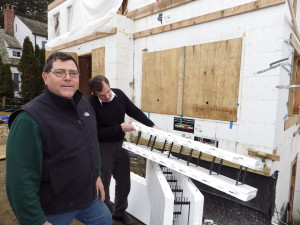Most house building sites don”™t feature a high-resolution computer rendering as big as a movie poster out front. But 15 Shore Road in Old Greenwich is different, at least underneath.
The picture serves as a reminder to the cyclists, joggers and residents of the tony neighborhood that more than a giant foam igloo currently there is on its way.
By May, when Mamaroneck-N.Y.-based Murphy Brothers”™ President Chris Murphy moves in, the foam shell with its cement core will have morphed into a “waterfront colonial,” complete with cupola.
Chris Murphy lives now in Rye, N.Y. For him and wife, Diane, who helped design the foam house, their new home represents a physical downsizing ”” from 5,000 square feet to 2,700 square feet ”” accompanied by a massive downsizing in utility bills, perhaps 75 percent, he estimates.
The energy savings accrue even before he and Diane and three of their children move in via the HVAC unit. It is sized via industry standards at “3 tons,” exactly half what a standard-built house”™s 6-ton HVAC unit requires; a ton being the cooling power in a ton of ice across 24 hours.
At 2,700 square feet, the house makes up in its clever use of space what it lacks in McMansion proportion. Bedrooms are minimized, while closets have expanded; and the kitchen spills into a family room, presenting by layout the food-relaxation equation. The first floor also has a den and office. The basement, which does not factor in the square footage, will be finished.
Chris Murphy called the design scheme “an attention to space” gleaned across 35 years in business. “Diane gets the credit for making it beautiful,” he said.
The foam construction technique is about 5 percent more expensive than timber-framed construction, according to the Murphys, but they expect the price to fall ”” perhaps quite a bit ”” when they offer the service to clients. As with any process, they explained, the steepest learning curve with insulated concrete forms (called ICFs) comes with the early projects.
Murphy and his brother, company Vice President Sean Murphy, toured the site recently. The house is already of interest to builders and architects for the use of cement-filled ICFs made by Nebraska-based Fox Blocks, a division of Airlite Plastics Co. in Omaha.
Another cutting-edge aspect will be on the roof. Rather than solar panels, the house will feature Dow PowerHouse solar shingles, which are flexible and which maintain the same low profile as standard asphalt shingles. In keeping with the Shore Road home”™s role as a teaching center, Murphy Brothers is an authorized PowerHouse dealer now urging clients to, “Rethink your roof.”
The brothers believe, without knowing an address, that prior to the real estate downturn in 2007-08 another foam house may have been built in the county. “But with the recession, you saw a drop off in any technique that was new,” Sean Murphy said.
The Shore Road effort is actually the Murphys”™ second foray into foam construction. They built a foam-and-cement foundation in Larchmont, N.Y., 10 years ago. “That was when I thought we could do an entire house like this,” Chris Murphy said. “I always wanted to use it.”
A serendipitous trip to Las Vegas last year sealed the deal when the Murphys (along with their architect Rex Gedney of Rye, N.Y.) came upon the Fox Blocks building booth at a trade show.
For the brothers, memories of the 10-year-old foam foundation job in Larchmont were now back in play.
Murphy Brothers, which employs 45, has a target region of Westchester, the Hudson Valley and Fairfield County. About 35 percent of company work is light commercial, including, for example, building the new staff housing at Winged Foot Golf Club in Mamaroneck, N.Y. The remaining 65 percent is high-end residential: new construction, whole-house renovations and other major renovations.
As for the foam construction, the brothers alternated in offering descriptive: “great sound reduction,” “very green,” “healthy ”” no volatile organic compounds” and finally “airtight.” The project broke ground in December.





















The picture serves as a reminder to the cyclists, joggers and residents of the tony neighborhood that more than a giant foam igloo currently there is on its way. …shouldn’t this say “tiny neighborhood?”